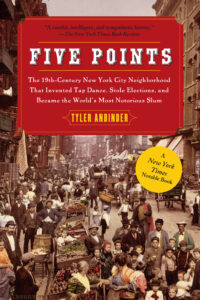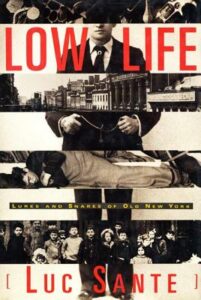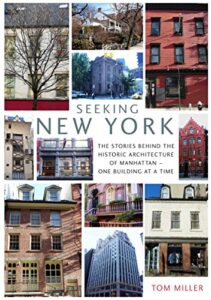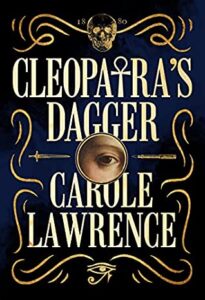When my publisher asked me to write a new historical crime series with a female protagonist, my first thought was to set it in New York, where I live. I thought I knew something of the city’s history, having wandered its streets happily for many years in search of historical treasures—old buildings, hidden secrets in dark alleys, street names reminiscent of its Dutch past—even visiting the caves once inhabited by its native people, the Lenape tribe, who gave Manhattan its name (“the island of many hills”).
I am a frequent visitor to the New York Historical Society and the Museum of the City of New York; I had two friends who were city tour guides I thought the research would be a breeze, so much easier than my deep dive into Edinburgh’s past for my Ian Hamilton Mysteries. I love Edinburgh, but I am only a visitor there; I have spent most of my life in New York. And, after all, New York is a fairly young city compared to the ancient Scottish capital, with human settlers there recorded as far back as 8500. Piece of cake, right?
Wrong. Oh, so very, very wrong. New York is an onion with endless, overlapping layers. I could study it for the rest of my life and only scratch the surface of what there is to know. It is vast and deep and endless—its importance to our country and to the world can hardly be overstated. It is, and has been for centuries now, the city at the center of the world—a trend setter in art and music, theater, finance, capitalism, fashion, and, dare I say, the future.
But I am concerned now with traveling into its past. And in order to help any of you who might be so inclined, here are a few of the many invaluable books that have helped me on that journey.

David Oshinsky, Bellevue: Three Centuries of Medicine and Mayhem at America’s Most Storied Hospital
The subtitle of Bellevue, David Oshinsky’s masterful historical account of Bellevue Hospital, reads “Three Centuries of Medicine and Mayhem at America’s Most Storied Hospital.” To call what transpired in the country’s oldest hospital “mayhem” is no exaggeration. In its early days, the constant parade of derelicts, drunkards and delinquents was matched only by the equally ubiquitous presence of disease, disaster and despair.
But by the time Bellevue came into its own in the late 19th century, it was a bustling center of innovation, boasting brilliant surgeons like Valentine Mott and William Halsted (who battled cocaine addiction much of his life). It was also home to Frank Hamilton, an arrogant physician whose refusal to follow the principles of antiseptic medicine already widely in use in Europe—leading to the death of President Garfield. After the president was shot by the deranged Charles Guiteau, Hamilton and others probed the wound with unwashed fingers, probably causing the blood infection which eventually killed the president.
Bellevue played a role in many central events in both the city’s and country’s history, hosting too many celebrities to mention. Stephen Foster died there, as did Huddie William Ledbetter, the musician better known as Lead Belly. Disrepair and neglect continues to haunt the halls of the hospital today, even as it did under the leadership of the great Stephen Smith, who was instrumental in bringing down the notorious Boss Tweed, the corrupt figurehead of Tammany Hall.
The history of Bellevue is, in many ways, the history of New York City. I recommend it to any writer of historical fiction set there—and to students of history everywhere.

Tyler Anbinder, Five Points: The Nineteenth-Century New York City Neighborhood That Invented Tap Dance, Stole Elections and Became the World’s Most Notorious Slum
The cover image of Tyler Anbinder’s engaging and lively Five Points portrays the overcrowding and chaos common to one of the world’s most legendary slums, but fails to capture its squalor and violence. No one had a better eye for poverty and wretchedness than Charles Dickens, and his account of the place, written in 1841, is famous:
Let us go on again…and…plunge into the Five Points…. We have seen no beggars in the street by night or day, but of other kinds of strollers plenty. Poverty, wretchedness, and vice are rife enough where we are going now.
This is the place—these narrow ways, diverging to the right and left, and reeking everywhere with, dirt and filth. Such lives as are led here bear the same fruits here as elsewhere. The coarse and bloated faces at the doors have counterparts at home and all the wide world over. Debauchery has made the very houses prematurely old. See how the rotten beams are tumbling down, and how the patched and broken windows seem to scowl dimly, like eyes that have been hurt in drunken frays. Many of those pigs live here. Do they ever wonder why their masters walk upright in lien of going on all-fours? And why they talk instead of grunting?
Grunting indeed. To Dickens, and many living outside of the Five Points, its inhabitants must have appeared little better than swine. They were the immigrant poor, the old, sick and disenfranchised, trapped among the criminal element who preyed upon them. They were the workers who toiled in the dirty and unforgiving streets, the prostitutes and chimney sweeps, laborers and seamstresses who took the jobs no one else wanted—as well as those whose only employment was crime.
The triangular area, encompassing part of today’s Chinatown, as well as some of the court district, was the epicenter of all the injustice and social inequality in an increasingly divided city. The book’s full title says it all. Five Points: The Nineteenth-Century New York City Neighborhood That Invented Tap Dance, Stole Elections and Became the World’s Most Notorious Slum.
It’s as close to a page turner as any history book can be—I hope it becomes a part of your permanent collection, as it has mine.

The first time I read Lucy Sante’s Low Life: Lures and Snares of Old New York my first thought was. “Wow! How does anyone hold so much information in their head?” That was shortly after the book’s publication, nearly twenty years ago.
No one can make a list like Sante. Her prose twines and twists and circles back on itself like a hungry snake in search of its own tail. Here she is describing gang warfare on the Lower East Side: “These battles lasted for days at a time, with the amalgamated gangs massed behind barricades of piled carts and paving stones, fighting with every weapon then available: fists, feet, teeth, bludgeons, brickbats, rocks, knives, pistols, muskets, on several occasions even cannons.”
For the writer in search of a deep dive into the seedy underbelly of Olde New York, there can be no better reference book than Sante’s.

Tom Miller, Seeking New York: The Stories Behind the Historic Architecture of Manhattan—One Building at a Time
The historical photographs in Tom Miller’s beautifully illustrated and annotated Seeking New York are plentiful, but even more appealing are Jenny Seddon’s charming pen and ink drawings of the buildings at the top of each chapter. The book is organized by neighborhoods: Chinatown, Murray Hill, Harlem, etc. Miller weaves architectural details of the buildings seamlessly into a concise historical account of each one, along with fascinating facts about the neighborhoods and surrounding streets. The book is begging for a sequel—by necessity, many wonderful and important structures were left out—the Puck Building, the Chrysler Building, the Hamilton Grange, to name just a few. No matter, there is so much here to enjoy and mull over, many hours of fascinating reading.
I was also delighted to see that Miller is a fellow Buckeye, having emigrated from Dayton not long before I moved to the East Coast myself. He might even be a cousin—I have Millers on my father’s side of the family! In any case, I hope he is planning a sequel.
He does have a blog: http://daytoninmanhattan.blogspot.com/
I have already subscribed. I hope you will too.
Esther Crain’s fascinating and comprehensive The Gilded Age in New York is packed with information presented in lively and graceful prose. The first paragraph gives a brilliant bird’s eye view of a city on the move:
In 1866, New York’s population of just over 800,000 was concentrated below 23rd Street. Residents traversed cobblestone roads by horsecar and illuminated their homes with candles and gas lamps. The tallest structure of what could barely be called a skyline was Trinity Church’s 281-foot spire on lower Broadway. For entertainment, New Yorkers paid twenty-five cents to gaze at the oddities in Barnum’s Museum near City Hall, or they took in one of the musical comedies in the Theater District on Broadway near Union Square. To reach the new Central Park from downtown required a lengthy carriage ride up a bumpy Fifth Avenue past open fields; crossing the East River to the city of Brooklyn meant boarding a ferry. By 1900, the Empire City had become the Imperial City. New arrivals poured in from across the world and helped push the population to 3.4 million. Wealth generated by Wall Street and industrial labor fueled a housing boom of opulent Fifth Avenue mansions, gable-roof apartment flats, and rows of shabby tenements. Electric streetlights bathed nighttime sidewalks in a brilliant glow, espaecially along the new uptown Theater District approaching 42nd Street. Steel-frame office towers rose twenty stories and skimmed the heavens. Threading the metropolis were elevated train tracks, asphalt avenues, and a graceful bridge webbed with steel cables. Trains and cable cars carried the growing middle class from new residential enclaves uptown, in Harlem, and in Brooklyn to their jobs downtown and on Sunday outings to Coney Island. At the cusp of the twentieth century, New York was bursting with beauty, power, and possibilities.
Her command of her subject matter is evident from her wide range of source materials. In the first chapter we find quotes from Walt Whitman and George Templeton Strong, as well as a young soldier asking his mother to send more cake to the battlefield. There are also snippets from the New York Times, the New York Herald, and The Brooklyn Eagle. We get a glimpse of the three Booth brothers on stage together just a few years before John Wilkes’ terrible deed. She brings the draft riots to life in all their horror and tragedy. Each chapter has color illustrations to accompany the text, in the form of period photographs and paintings.
***


















